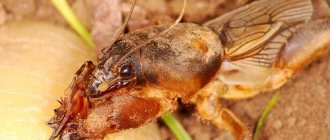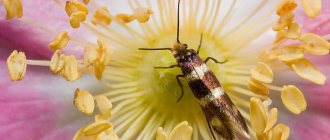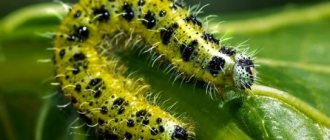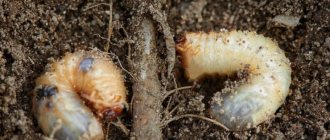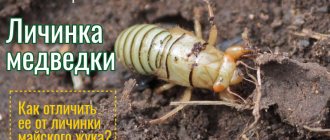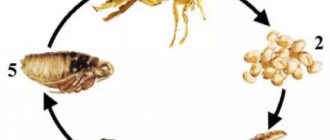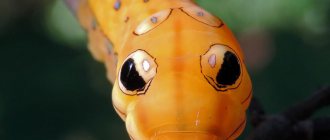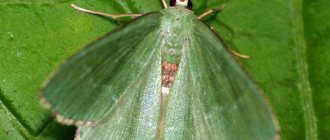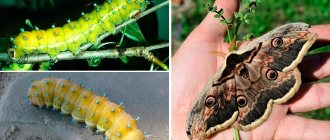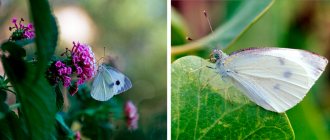Author: Elena N. https://floristics.info/ru/index.php?option=com_contact&view=contact&id=19 Category: Plant Pests Published: June 13, 2018Last edits: October 30, 2020
Moths (lat. Geometridae), or surveyors , are a large family of butterflies, numbering more than 2,000 genera and about 23,000 species. For garden and vegetable plants, the greatest danger is from moth caterpillars, which eat both cultivated and wild plants. Most often, in our climate, we find such representatives of the family as the pine and winter moths, the skinned moth and the gooseberry moth, or gooseberry.
Appearance of the insect and stages of development
Like butterflies, moths and moths, this pest belongs to the order Lepidoptera. Description of appearance:
- The length of the wings is from 22 to 25 millimeters, their span is from 43 to 50 millimeters;
- Thick, cone-shaped body;
- The fore and hind wings are covered with chitinous scales;
- The body consists of three main sections: head, chest and abdomen;
- With the help of long antennae, which are sensory organs, they are able to perceive vibrations and smells;
REFERENCE: Sex differences are clearly visible in these pests. Males have more developed wings, females have smaller ones, and sometimes they don’t have them at all. The moth has a full development cycle.
- Has a light color;
- There is a pattern on the wings - black dots and longitudinal stripes;
- They are nocturnal.
Its stages of development:
- Egg;
- Larva (caterpillar);
- Pupa;
- Adult (imago).
Birch moth caterpillar:
Evolution of color or type of adaptation
The birch moth is capable of changing its color. The acquisition of this feature was influenced by external factors caused by human activity. The process of natural selection that caused the appearance of dark coloration is called industrial melanism.
Until the middle years of the 19th century, insects had white wings with black spots. Using this color scheme, butterflies were perfectly camouflaged on birch bark. They could also hide in lichens and enemies would not notice them. Later, colonies of moths of the same color began to appear near the large industrial centers of Europe and North America. The pests changed their main color to black.
REFERENCE: In areas without developed industrialization, the color of butterflies remains light. There is also an intermediate species of butterflies that live in the border strip of industrial areas; their color is gray with a black pattern.
How to get rid of and how to treat lichen
Sooner or later, lichens appear on the bark of cedars that are not sufficiently blown with air and poorly illuminated by the sun. They retain moisture and dry poorly after rain. In winter, the surface under the lichen may crack due to freezing of water crystals in it. It also provides a good shelter for pathogenic microflora and some pests.
Therefore, lichens must be removed from the trunk.
To work, you will need a stiff brush: it should be elastic enough to help clear the vegetation, but not damage the trunk. The cleaned area must be wiped with iron sulfate (300 g/10 l of water) - this will prevent the further development of spores that could remain in the cracks.
Read how to get rid of moss and lichen on currants and gooseberries.
Appearance of an insect
The moth is a small butterfly with a rather thick body. The wingspan of adults is 4-5 cm. It is curious that initially all butterflies of this species were light gray in color with many dark pigments. However, in recent years their color has undergone dramatic changes. Thus, the birch moth became much darker, and the once clear spots began to completely merge with the body.
The reason for this was evolution: because of life in the city, butterflies were forced to adapt to the colors of the surrounding world, because otherwise they would have become easy prey for birds. Those insects that live in the forest still remain true to their old war paint.
By the way, such metamorphoses are very useful for ecologists’ research. By observing the colors of butterflies, they can determine how polluted their region is. With this in mind, it's nice to know that even the worst pest has its positive sides.
Preventive measures
Like other conifers, cedars are susceptible to diseases that can damage them or cause death. And this does not depend on where the tree grows - in the forest or in the park. In addition, old, rotten or diseased cedar poses a potential danger to the safety of people in populated areas
For these reasons, it is important to take timely measures to prevent diseases
Factors influencing the health of cedars are:
- fungi that parasitize them;
- climatic conditions;
- planting site, including soil composition, watering.
It is difficult to accurately diagnose diseases. They can occur without visible symptoms - for example, infection of a tree with bark beetles or rotting of roots at the initial stage. Loss or discoloration of needles can be caused by stress from drought or flooding, damage from herbicides, mites, fungi
And this also becomes an important reason to start with prevention, without waiting until it is time to treat the tree.
Prevention includes:
- regular sanitary inspections of the condition of trees;
- planning plantings taking into account the condition of the soil and taking measures to improve it;
- managing the conditions in which cedar grows.
It is necessary to consider whether the site prepared for planting is susceptible to flooding, drought or soil compaction. If possible, you should eliminate the shortcomings, and then select varieties that can grow in your existing conditions.
When purchasing a seedling from a nursery, you need to find out what diseases a particular variety is susceptible to, the timing and conditions under which they appear.
This will allow you to plan a schedule for treating the tree with fungicides to prevent infection. It is also a good idea to check with your local gardening societies to see what diseases are common in your area. This will assist in identifying the problem and selecting the best strategy for chemical treatment.
If a diseased tree is discovered, you will need to assess the extent of the problem. In case of minor damage, it is necessary to remove the infected branches, treat the wound with a solution of Bordeaux mixture 1% and cover it with garden varnish.
Important! Tools used for work must be wiped with alcohol before and after pruning, so as not to transfer phytopathogens from diseased cedars to healthy ones. Pests and diseases can spread very quickly, so treatment should begin as soon as the first signs of a problem are noticed
Keep in mind that it needs to be done several times in order to destroy those insects that hatch later from the laid eggs. This will not only keep the cedars healthy, but will also support their immunity.
Pests and diseases can spread very quickly, so treatment should begin as soon as the first signs of a problem are noticed. Keep in mind that it needs to be done several times in order to destroy those insects that hatch later from the laid eggs. This will not only keep the cedars healthy, but will also support their immunity.
Butterfly breeding season
With the arrival of May, the mating season begins for birch moths. Intoxicated by pheromones, they flock to each other and begin to circle in a ritual dance. And if the partner is suitable for the female, then soon they begin the act of intercourse. It lasts only a fraction of a second, but this is enough to pollinate the thousands of eggs that the “lady” carries.
After this, the birch moth looks for a safe place for future offspring. Often this is a crack in the bark of a tree or a small hole in its trunk. On average, one female can lay from 700 to 2000 eggs. And just imagine how much food this colony needs at the moment of its awakening!
In addition, the caterpillars develop throughout the summer. That is, they have three whole months to destroy local gardens. And only with the arrival of autumn they burrow into the ground, where they turn into pupae. And in the spring, the whole process of metamorphosis is repeated again in a circle that has been rolled over centuries.
Folk remedies
Pesticides are very effective in controlling many harmful insects. But it should be taken into account that they contain toxic substances that can accumulate in fruits. If there are not very many pests, then experts recommend not using powerful insecticidal preparations; they can be replaced with folk remedies, of which there are many. If we compare the effectiveness of folk remedies and chemicals, it is no more than 30–40 percent, which is why several regular treatments are required to destroy the pest, but in the end you will be able to save not only the plant itself, but also the quality of the fruit.
Most often, gardeners resort to using the following folk remedies:
- Decoction of tomato tops . Pour 1 kilogram of finely chopped tomato tops into a bucket of water, mix everything and leave the mixture for 4–5 hours. After that, bring it to a boil and keep on low heat for 2 to 3 hours. The cooled and strained product is diluted with water in a ratio of 1:1 .
- Burdock infusion . Fill the bucket 1/3 full with finely chopped burdock leaves, then pour water into it to the brim. The infusion will be ready after three days, it is filtered and they begin to spray the bushes.
- Euphorbia decoction . Half a bucket of water is combined with four kilograms of finely chopped spurge sprouts. The mixture is boiled for 2.5–3 hours, the cooled and strained broth is poured into a bucket and water is added to it to the brim. This product is enough for a couple of treatments, with the first of them carried out after the appearance of the caterpillars, and the second - four days after the first.
- Hot pepper decoction . Combine a liter of water with 0.1 kg of crushed hot pepper fruits, boil the mixture for 60 minutes and leave it for two days to infuse. Then grind the pepper directly in the broth until it becomes mushy. The strained broth is used as follows: pour 1 tbsp into 1 bucket of water. products and 50 mg of liquid soap (for better adhesion).
- Wormwood decoction . Combine 2 liters of water with 1 kilogram of wilted wormwood herb, boil the mixture for 10 to 15 minutes. The cooled broth is filtered and poured into a bucket, into which water is then poured to the brim. Treat plants with the product regularly once a week.
- Infusion of yarrow . Pour 0.8 kg of dried yarrow herb, which is collected during flowering, into a container. It is poured with freshly boiled water and left for 30–40 minutes, after which this infusion is poured into a bucket and water is added to it to the brim, and again the product is allowed to brew for 40 minutes. Before you start spraying the plants, strain the product and mix it with 50 ml of liquid soap.
- Tansy powder . Dried shoots, leaves and flowers of tansy are ground to a powdery state and the plants are dusted with it.
Tree Defiler
The caterpillar of the birch moth butterfly is one of the most dangerous pests living on the territory of the Russian Federation. Having hatched from the egg, they begin to eat everything that comes along the way, be it leaves, buds, buds, flowers or fruits. And given their number, it is not difficult to guess that literally in one day they can destroy a good part of the greenery on a tree.
Therefore, gardeners try to treat their trees in advance so that they are not attacked by omnivorous caterpillars. In addition, in this difficult struggle, some species of birds come to the aid of people. After all, if adult butterflies are protected by camouflage color, then their offspring are easier and more nutritious prey.
Prevention measures
In order to protect plants and crops from moths, preventive measures are taken already in the fall, namely, clear the surface of the soil near the plants from flying leaves and destroy them. Then dig up the soil in the trunk circle of shrubs and trees. In early spring, you will need to carry out two preventive sprayings of garden crops; for this, use Karbofos or another product with a similar effect. The first treatment is carried out after the buds begin to open, and the second - when the plants fade. After the fruits have formed on the bushes or trees, it is recommended to use only herbal infusions or decoctions for spraying them.
As a preventive measure, try to take good care of the plants and follow the rules of agricultural technology, since all gardeners know that harmful insects do not settle on strong and healthy plants. In this regard, clean the surface of the tree trunk circles, remove weeds in a timely manner, carry out regular weeding and watering, and then moths may never settle on your trees and shrubs.
Bapta temerata
| Synonyms | Birch moth, entire birch moth, entire birch moth |
| In English | Bapta temerata |
| Class | Insects – Insecta |
| Squad | Lepidoptera (Butterflies) – Lepidoptera |
| Family | Moths – geometridae |
| Biological group | Pests of stone fruit crops; Pests of fruit and pome crops; Pests of fruit crops; Forest pests; Pests of ornamental crops; Pests of urban green spaces |
| Special marks | Common type |
| The entire birch moth is a pest of apple, cherry, and plum trees. In addition, it harms beech, oak, willows, birch, maple, roses and thorns by eating leaves. Reproduction is bisexual. The pupa overwinters in a dense compact cocoon in the soil. One generation of the pest develops per year. | |
| Summary data | |
| Fertility (pcs) | 100 |
| Generations per year | 1 |
| Egg(mm) | length 0.61-0.69 mm width 0.4-0.5 mm |
| Larva (mm) | 20-25 |
| Pupa (mm) | 9,8-10,5 |
| Wingspan (mm) | 22-25 |
Food cravings
The winter moth (operophtera brumata) is found in the central and northern parts of Europe, in the south, the European part of Russia, the Primorsky Territory, and the Caucasus.
The pest's diet is quite extensive, including about 100 plant species.
Important! Winter moth caterpillars destroy the buds, flowers and leaves of many trees: apple trees, cherries, pears, bird cherry trees, oak, maple, beech, hazel, birch and many others.
While feeding, the caterpillars make holes in leaves and flowers, leaving cobwebs in the damaged areas.
By the end of the third week, nothing remains of the leaves, only veins. Grown-up caterpillars can climb into the ovaries of apple or pear trees, and damage the seeds of cherries or plums that have not yet become hard. If a tree is seriously damaged by the winter moth, it does not bloom and fruit does not set.
Morphology
Imago. Small butterfly. Wingspan – 22–25 mm. [2] Like all representatives of the moth family, it has a thin, slender body and wide triangular upper wings, rounded hind wings, and a developed proboscis. It feeds on the nectar of flowers. [1]
The main color of the wings is white. The pattern of the front wings is formed by dark gray, sometimes merging transverse stripes, as well as small brown and dark gray spots. The pattern of the hind wings is similar to that of the front wings, but is less marked. Along the outer edge of the wings along the light brown fringe there are brownish-gray or dark gray crescent-shaped and triangular spots. [2]
The egg is oval in shape, length – 0.61–0.69 mm, width – 0.4–0.5 mm. The color changes as it develops from light yellow-green to ocher and brown-olive. [2]
The larva (caterpillar) reaches 20–25 mm in adulthood. The body is almost cylindrical. The head is smoothly rounded on the sides, with black-brown spots. The main body color is whitish-green. The back and lateral lines are whitish-yellow. [2]
Doll. Length – 9.8–10.5 mm. The cremaster is triangular in shape with two large, lyre-shaped apical processes, as well as six small hooks twisted at the end. [2]
| Phenology of development (in days) | |
| Transformation | Complete |
| Full cycle | 1 year |
| Egg (embryo) | 10-15 |
| Larva | 2-3 months |
| Doll | 8-9 months |
Fruit mites
Fruit mites mainly reproduce in the summer, at times when pyrethroid preparations are used as an insecticide. The most common is the red fruit mite. It is an insect measuring 0.4 mm, first red, then red-brown in color. During the month of her life, the female lays up to a hundred red spherical eggs with radial ribbing and a thin stalk at the top. Over the summer, the red fruit mite can produce from 4 to 8 generations. Eggs of the summer generation are mainly laid along the leaf veins, on its underside. Closer to winter, females lay eggs in the periphery of the crown on young shoots. The eggs overwinter on the surface of the rough bark. When a tree is severely damaged, the bark appears reddish-brown.
After overwintering before the flowering of apple orchards, the eggs hatch into larvae, which through the nymph stage turn into an adult insect. After a week, the red fruit mite is already capable of reproducing.
Through their sucking mouthparts, mites suck out the juices from the leaves, causing the foliage to dry out and fall off. Plums shrink and become small. With massive infection, a third of the crop may be lost.
In case of infection of a plum orchard with red fruit mite, avoid the use of pyrethroid drugs. At the moment of maximum hatching of larvae, insectocaricides are used: fufanon, danadim, fitoverm, etc. For mass reproduction of mites, specific preparations are used, such as sunmite, neoron, nissoran, apollo, demitan, omaite, etc.
Development
Imago. The flight of butterflies in Polesie and the Forest-Steppe of Ukraine is observed from early May to mid-July; the mass flight occurs in June. [2]
Mating period. The female lays up to 100 eggs in clusters on the leaves or ends of young shoots. [2]
Egg. Embryo development lasts 10–15 days. [2]
Larva (caterpillar). The caterpillars emerging from the eggs are inactive and develop slowly. Until the third instar, they stay in groups and gnaw out fairly large holes in young leaf blades. Older larvae are located with their abdominal legs at the base of the central vein and roughly eat leaves in the nearest accessible areas. The development of the caterpillar continues from July to August. [2]
What about the willow? Spots on leaves
1. Before the buds open, you need to treat the trees with a 2-3% solution of Bordeaux mixture. Repeat treatment with a 1% solution during budding and after flowering. 2. In the same phases, treat the first time with 1% copper sulfate (blue spraying), the second time with copper oxychloride, or ordan, oxychome. You can use the drug Abiga-Pik. The third spraying is carried out with cuprosil or 1% Bordeaux mixture. Some gardeners recommend repeating spraying with 1% Bordeaux mixture after 10-12 days. 3. The chemical fungicide topaz is effective against rust.
. Three times treatment is enough to protect against rust. Treatments begin in the bud breaking phase, immediately after flowering and in the fruit growth phase (if it is a fruit tree).
Biological products can also be used
: trichodermin, planriz, phytosporin-M, gamair (bactericide), phytodoctor, gaupsin. The latter drug stands out for its dual action. It not only destroys fungal diseases, but also a number of pests.
And, finally: if you have juniper growing on your site (or your neighbors), then carefully inspect and treat it at the same time, because He is the conductor of this disease. Rust also loves to “attack” pears.
Birch moth
The insect is considered one of the most common species; the length of the wings can reach forty millimeters, the wingspan is thirty to forty millimeters. The wings are distinguished by a gray tint with broken stripes, dots and small light spots.
The insect is considered one example of driving selection associated with industrial melanism. Until the middle of the 20th century. individuals of this species were distinguished by a light gray color; as industrial production developed, the color of the insects began to darken, as did the trees covered with soot.
As a result, birch moth butterflies of darker color began to predominate, since light ones turned out to be more accessible for birds to eat.
Damage to plants is also caused by moth caterpillars; on the back of the insects there are elevations that visually resemble warts, the central part is green, and there are brown spots at the ends.
Butterflies are found from mid-June to August and fly most often at night. All moths differ from each other in their habitat, wing color, place of pupation, body shape, and time of appearance.
Known species of moths are also considered to be the great green moth, the gooseberry moth, and the winter moth. Male winter moths have fairly developed wings; the butterflies appear in late autumn.
The pest causes the greatest damage to garden plants; the caterpillars hatch in the spring and burrow into the buds, later moving onto the leaves. In May-June, the caterpillars pupate, for which they burrow into the soil; a massive invasion of insects threatens the complete disappearance of foliage.
What plants are affected?
The moth feeds on the leaves of fruit trees (plum, cherry, apple), it also affects maple, birch, willow, oak, beech, and you should also be wary of thorns and roses.
Sources
- https://web-selo.ru/berezovye-pyadenitsy-vred-nanosimyj-babochkami-i-mery-borby-s-nimi.html
- https://fb.ru/article/253949/berezovaya-pyadenitsa—vreditel-kotorogo-nujno-znat-v-litso
- https://www.pesticidy.ru/%D0%9F%D1%8F%D0%B4%D0%B5%D0%BD%D0%B8%D1%86%D0%B0_%D0%B1%D0%B5 %D1%80%D0%B5%D0%B7%D0%BE%D0%B2%D0%B0%D1%8F_%D1%86%D0%B5%D0%BB%D1%8C%D0%BD%D0 %BE%D0%BA%D1%80%D0%B0%D0%B9%D0%BD%D1%8F%D1%8F
- https://rusfermer.net/ogorod/vrediteli/pyadenitsa/berezovay.html
[collapse]
Leaf-eating pests
Leaf-eating pests are a large group of insects. Their numbers are subject to sharp fluctuations. They are capable of populating vast territories; one species can attack plants of different varieties and ages. The most common are representatives of the order Coleoptera (Coleoptera) and Lepidoptera (Lepidoptera).
Adaptability to dispersal (butterflies fly, caterpillars crawl).
High fertility. One female green moth can lay up to 60 eggs, a female winter moth can lay more than 400 eggs, a female moth can lay up to 600 eggs, and a female gypsy moth can lay more than one and a half thousand eggs. Hatched caterpillars can completely eat the buds, young shoots and foliage from the tree. This can give the impression of a dead forest. The trees are greatly weakened, making them a target for stem pests. In the end, if urgent measures are not taken, the trees will die anyway.
The most common and dangerous leaf-eating pests are:
Oak green leaf roller (order Lepidoptera). The main food supply is oak. The butterfly is emerald green in color with a wingspan of 1.8-2.5 cm. The eggs are laid in pairs in irregularities in the bark or in the depressions of leaf scars and are covered with secretions that form a scute. In the spring, the eggs hatch into green caterpillars, which crawl into the buds, eat them up and settle in rolled-up leaves to pupate, feeding on them. Damaged oak leaves become infected with powdery mildew, the shoots slow down their development and, as a result, freeze out in winter.
Periods of mass reproduction of the green leaf roller are observed every 3-5 years. The increase in numbers is facilitated by the coincidence of the time when the caterpillars emerge from the eggs with the period of bud break. Severe winters, on the contrary, reduce the population.
Winter moth. Gray-brown butterfly with a wingspan of 20-25mm. Eggs are laid in groups of 10-20 near the buds, in internodes or in irregularities in the bark. The eggs overwinter and light green caterpillars emerge at the end of April. The caterpillars first feed on buds and then on young foliage. The winter moth is omnivorous. She loves oak, elm, birch, linden, maple, bird cherry, ash, willow, and fruit trees. After defeat by the winter moth, powdery mildew covers the foliage. Most often you can see the winter moth in neglected gardens, middle-aged oak forests or other plantings with oak.
The skinned moth (order Lepidoptera) is a polyphagous leaf-eating pest. Yellowish female moths do not have wings. Males are gray-yellow in color and have a wingspan of 35-40mm. Females climb the trunk to the tree crown, where they lay eggs in the branches. After wintering, caterpillars emerge from the eggs, which during May-June eat the foliage of birch, oak, linden, fruit trees and other species. The skinned moth is a good neighbor to the silkworm moth. As a rule, trees recover after a period of “famine”, but if they are damaged repeatedly they can die.
Gypsy moth. It got its name because of the sharp difference between males and females. The female is a large off-white butterfly with a wingspan of up to 75mm, the male is smaller, brown-gray in color. The female lays eggs from 300 to 1200 pieces in the lower part of the trunk, interlayering them with hairs from the abdomen. Thus, the masonry resembles a piece of felt. At the beginning of May, caterpillars emerge from the eggs, crawl up the trunk, and begin to eat the leaves. The gypsy moth is a pest of more than 300 plant species, including conifers, deciduous trees, shrubs, cereals and herbaceous plants. But most of all he loves the leaves of oak, poplar and fruit trees.
Mass reproduction occurs 2-3 years after dry years. Insects and entomophagous birds help reduce the number. Repeated infestation by gypsy moths leads to dry tops of plantations.

